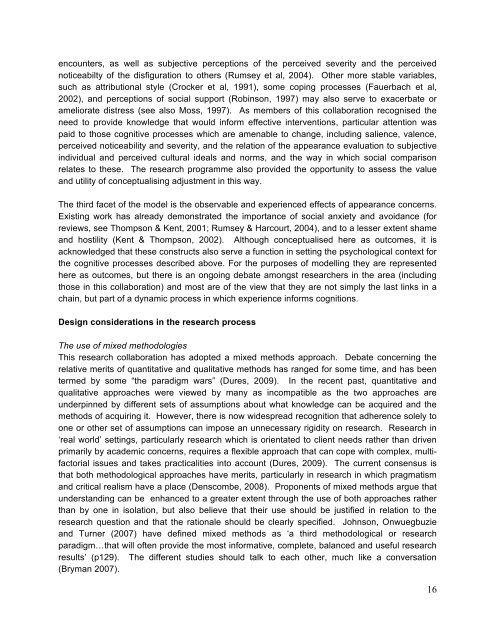Download the report - The Healing Foundation
Download the report - The Healing Foundation
Download the report - The Healing Foundation
Create successful ePaper yourself
Turn your PDF publications into a flip-book with our unique Google optimized e-Paper software.
encounters, as well as subjective perceptions of <strong>the</strong> perceived severity and <strong>the</strong> perceived<br />
noticeabilty of <strong>the</strong> disfiguration to o<strong>the</strong>rs (Rumsey et al, 2004). O<strong>the</strong>r more stable variables,<br />
such as attributional style (Crocker et al, 1991), some coping processes (Fauerbach et al,<br />
2002), and perceptions of social support (Robinson, 1997) may also serve to exacerbate or<br />
ameliorate distress (see also Moss, 1997). As members of this collaboration recognised <strong>the</strong><br />
need to provide knowledge that would inform effective interventions, particular attention was<br />
paid to those cognitive processes which are amenable to change, including salience, valence,<br />
perceived noticeability and severity, and <strong>the</strong> relation of <strong>the</strong> appearance evaluation to subjective<br />
individual and perceived cultural ideals and norms, and <strong>the</strong> way in which social comparison<br />
relates to <strong>the</strong>se. <strong>The</strong> research programme also provided <strong>the</strong> opportunity to assess <strong>the</strong> value<br />
and utility of conceptualising adjustment in this way.<br />
<strong>The</strong> third facet of <strong>the</strong> model is <strong>the</strong> observable and experienced effects of appearance concerns.<br />
Existing work has already demonstrated <strong>the</strong> importance of social anxiety and avoidance (for<br />
reviews, see Thompson & Kent, 2001; Rumsey & Harcourt, 2004), and to a lesser extent shame<br />
and hostility (Kent & Thompson, 2002). Although conceptualised here as outcomes, it is<br />
acknowledged that <strong>the</strong>se constructs also serve a function in setting <strong>the</strong> psychological context for<br />
<strong>the</strong> cognitive processes described above. For <strong>the</strong> purposes of modelling <strong>the</strong>y are represented<br />
here as outcomes, but <strong>the</strong>re is an ongoing debate amongst researchers in <strong>the</strong> area (including<br />
those in this collaboration) and most are of <strong>the</strong> view that <strong>the</strong>y are not simply <strong>the</strong> last links in a<br />
chain, but part of a dynamic process in which experience informs cognitions.<br />
Design considerations in <strong>the</strong> research process<br />
<strong>The</strong> use of mixed methodologies<br />
This research collaboration has adopted a mixed methods approach. Debate concerning <strong>the</strong><br />
relative merits of quantitative and qualitative methods has ranged for some time, and has been<br />
termed by some “<strong>the</strong> paradigm wars” (Dures, 2009). In <strong>the</strong> recent past, quantitative and<br />
qualitative approaches were viewed by many as incompatible as <strong>the</strong> two approaches are<br />
underpinned by different sets of assumptions about what knowledge can be acquired and <strong>the</strong><br />
methods of acquiring it. However, <strong>the</strong>re is now widespread recognition that adherence solely to<br />
one or o<strong>the</strong>r set of assumptions can impose an unnecessary rigidity on research. Research in<br />
‘real world’ settings, particularly research which is orientated to client needs ra<strong>the</strong>r than driven<br />
primarily by academic concerns, requires a flexible approach that can cope with complex, multifactorial<br />
issues and takes practicalities into account (Dures, 2009). <strong>The</strong> current consensus is<br />
that both methodological approaches have merits, particularly in research in which pragmatism<br />
and critical realism have a place (Denscombe, 2008). Proponents of mixed methods argue that<br />
understanding can be enhanced to a greater extent through <strong>the</strong> use of both approaches ra<strong>the</strong>r<br />
than by one in isolation, but also believe that <strong>the</strong>ir use should be justified in relation to <strong>the</strong><br />
research question and that <strong>the</strong> rationale should be clearly specified. Johnson, Onwuegbuzie<br />
and Turner (2007) have defined mixed methods as ‘a third methodological or research<br />
paradigm…that will often provide <strong>the</strong> most informative, complete, balanced and useful research<br />
results’ (p129). <strong>The</strong> different studies should talk to each o<strong>the</strong>r, much like a conversation<br />
(Bryman 2007).<br />
16


